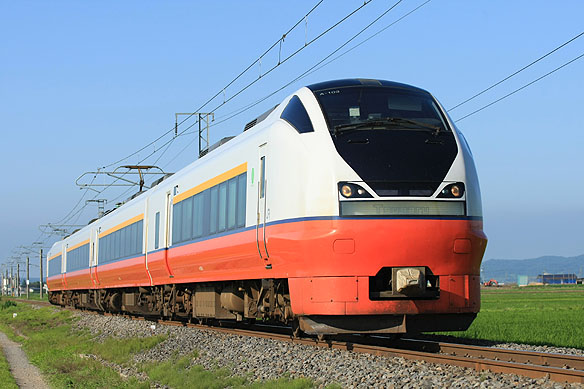In 1999, JR East developed E751 series AC electric multiple unit (EMU)
in order to displace the superannuated 485 series which were used on the
"Hatsukari" intercity services linking Aomori and Morioka. The
design was based on the earlier (1,500 VDC) E653 series EMUs, with improvements
to cope with colder weather conditions in the north of Japan.
The vehicle design incorporates light weight double skin car body shell of aluminum alloy hollow extrusion. Rails for attachment of interior panel modules and outfitting modules are shaped in the double skin structure. Cab sections adopt high front cab and are not equipped with pass-through door at the front end.
Bogies, DT64A/TR249A are based on the DT64/TR249 used on E653 series. They adopt the bolster-less air suspension, and their journal box supporting system is axle arm type. These bogies adopt the yaw dampers to ensure smooth ride characteristics even at 130km/h.
Traction systems, which consist of the converter and 3-level AVAF inverter
adopting IGBT modules, drive 4 AC 3-phase asynchronous motors rate at 145kW.
Gear ratio at 5.66 gives a maximum design speed of 140km/h. E751 series
feature the electric commanding brake with regenerative brake.
All seating is adjustable reclining. 1st class and standard class vehicles have 2+2 abreast seating. The seat pitch of the 1st class is 1160mm and the standard class is 910mm in order to increase seating capacity. LED information indicators are located at the both end of passenger room. Destination indicator panels by LED are fitted on each side of the body.
E751 series were used on the "Tsugaru" intercity services linking
Hachinohe and Aomori after the start of the operations on the Tohoku Shinkansen
between Morioka and Hachinohe. Now E751 series are used on "Tsugaru"
intercity services between Aomori and Akita. |
|

